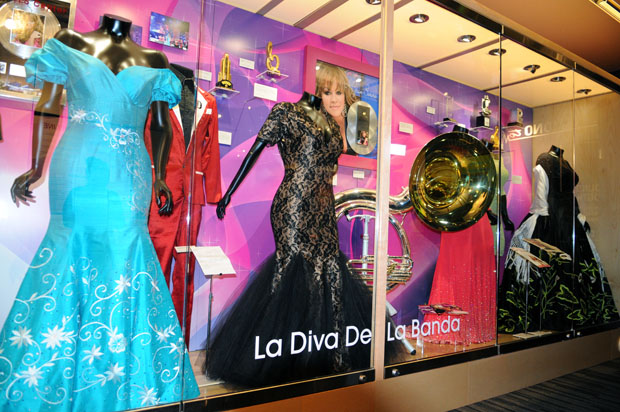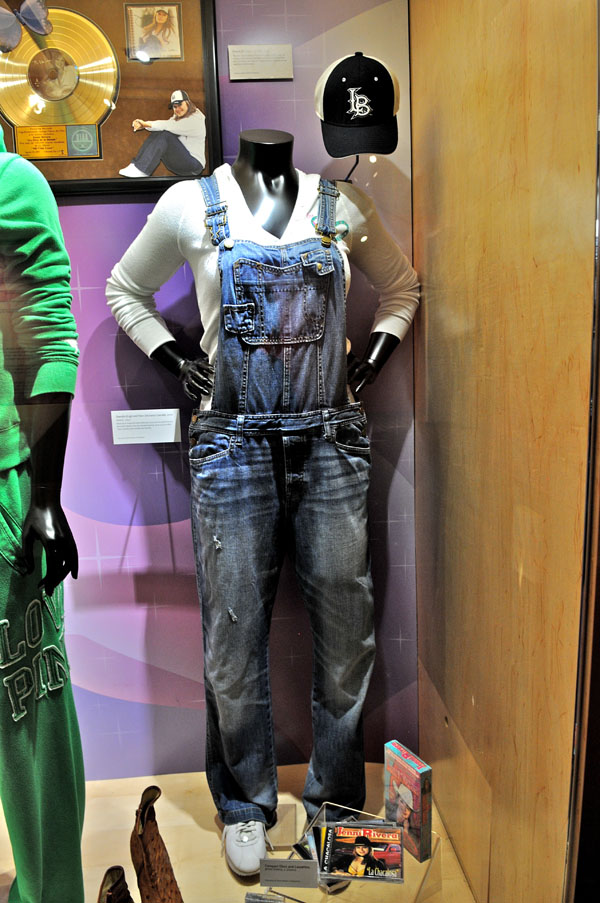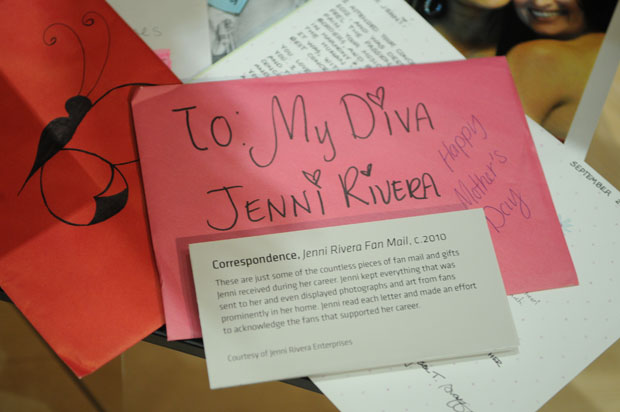
Photos by Lydia Chain
Since the untimely death of Long Beach-bred “La Diva de la Banda” Jenni Rivera in December 2012, fans on both sides of the border have been clamoring for her memory to be honored. And for its first big show ever to be presented on a Latin artist, the Grammy Museum in Downtown Los Angeles is giving Rivera’s influential music, dramatic life and entrepreneurial spirit the respect that it deserves.
Opened on Sunday, May 12, Jenni Rivera, La Gran Señora showcases several of the one-time Poly High School student’s personal artifacts, projects from her entrepreneurial empire, as well as many of her favorite on and off-stage outfits. Also on display is the wedding ring from her third marriage to Esteban Loaiza–of which replicas were later mass-produced by Los Angeles jewelry company Icing On The Ring–as well as her personal Bible that she often brought with her when traveling.
 Also timely is a Mother’s Day trophy her children had made for her and the Mexican-American singer’s favorite Long Beach State baseball hat like the one that she’s pictured wearing on the cover of her early album Mi Vida Loca.
Also timely is a Mother’s Day trophy her children had made for her and the Mexican-American singer’s favorite Long Beach State baseball hat like the one that she’s pictured wearing on the cover of her early album Mi Vida Loca.
The exhibition was curated in less than six months by Nwaka Onwusa who worked closely with the family to offer Rivera’s fans a closer look at some of her better-known personal effects. Onwusa says that she had been trying to coordinate something with Rivera before her passing, but it never came to fruition until she approached the family again in order to keep her legacy alive. She also states that the items that Rivera valued most were those that connected her to being a mother. Onwusa went on to discuss how, though she never met or saw Rivera perform, she was choked up trying to plan the exhibit with the family.
Grammy Museum Executive Director Bob Santelli sees the exhibit’s importance as one beyond Rivera’s lasting legacy as the first woman to gain success in the male-dominated world of norteño and banda music. The initiative to introduce Latino artists to non-Latino Angelenos and other travellers who flock to the area in the summer is also a major factor. He acknowledges that the museum has not embraced Latino artists perhaps as much as it should have, but he feels that Rivera is the perfect example of celebrity that can bring fans in as well as having an enthralling story by which any visitor will be impressed.
Like all the other boundaries that she broke in her life, Rivera is the first Latino artist to have an exhibit in the Grammy Museum, further highlighting how she used her status to eradicate stereotypes of women in Mexican music.
Santelli plans on implementing educational programs in the Los Angeles region by which students of all backgrounds can come to the exhibit to learn about Rivera’s entrepreneurial spirit and versatility through her music. He believes that her rags-to-riches tale can be used to further inspire those with similar backgrounds to not give up on the American Dream.
Santelli likens her roots to those of the famed Bruce Springsteen, and although not musically similar, their pasts are alike and their personalities undeniably likable.
Born in Long Beach, Rivera never shied away from the fact that she did not have an ideal childhood. Even later in married life she was stifled by the constraints of the subservient wife role prevalent in Mexican culture. But her persistence and drive to provide for her family molded her into a stronger woman.

Not only did she strive to succeed in her personal life–though she dropped out of high school when she got pregnant, she eventually earned a degree at Cal State Long Beach and made a living selling real estate–she was also concerned about other women and children who came from similarly disadvantaged situations. Not only was she involved with several charitable organizations but, as Santelli points out,
“She was a charismatic woman who made fans feel like friends and created an almost intimacy that not many people can illicit,” Santelli says.
The exhibit focuses on Rivera’s contribution to informing the general public of the relevance of norteño, banda, mariachi and other Latin styles of music, which are gaining importance because of the ever-growing Latino contingency in the United States.
The Grammy Museum is located at 800 West Olympic Blvd., Los Angeles, (213) 765-6800, grammymuseum.org. La Gran Senora will run for one year.
Read more:
- UPDATED: “No Survivors” In Crashed Plane; Banda Star Jenni Rivera Presumed Dead
- Kidnapping, Psychics and Rumors: Family and Fans of Jenni Rivera Believe She Is Still Alive
- Whatever Happened to Suburban Rhythm? The Unsung Music of Long Beach, California: Part 1
{FG_GEOMAP [34.04503,-118.2656326] FG_GEOMAP}

